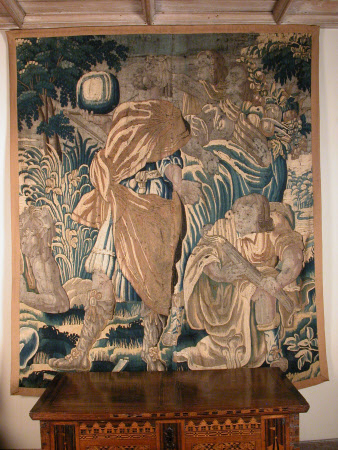Geometry and the Elements
Flemish
Category
Tapestries
Date
circa 1640 - circa 1680
Materials
Tapestry, wool and silk, 4½-5 warps per cm
Measurements
2100 x 1800 mm
Order this imageCollection
Packwood House, Warwickshire
NT 557884
Summary
Tapestry, wool and silk, 4½-5 warps per cm, Geometry and the Elements, Flemish, c. 1640-1680. In the centre stands a man wearing a faded yellowish cloak over a blue tunic, looking upwards and to the left. He holds an orb and a pair of dividers and at his feet is a set square. He is surrounded by personifications of the four elements. At the lower left is Water in the form of a reclining river god, partially cut off by the edge of the tapestry, with reeds growing behind him. To the right is Fire, crouching over a small flame and holding a bunch of sticks. Behind Fire are two standing females, Earth, wearing a blue cloak and holding a cornucopia, and behind her Air, pointing to the sky. The tapestry is coarsely executed and appears to have been cut down from a larger piece. It has no borders but a pale brown wool repp galloon has been attached around all four edges. Lining from this tapestry is in Queen Mary's bedroom cupboard store.
Full description
This tapestry bears a simplified version of a design that appears on a tapestry at Wawel Royal Castle, Cracow (Hennel-Bernasikowa 2000, cat. no. 24, pp. 98-100). The Cracow panel bears the signature of Jan II Raes (1570-1643) and the Brussels city mark, and is dated to c.1630, it measures 4.3 x 4.5 metres, and has a warp count of 7 warps per cm. The panel at Packwood is only 2.1 x 1.8 metres and has 4 warps per cm. Even allowing for its lack of borders the figures are considerable smaller, and the coarse weave has led to a dramatic simplification of the design. Although the four supporting figures can be clearly identified from their attributes as the Four Elements, the identity of the main figure is in doubt. In the related tapestry at Cracow this figure is identified as Archimedes, but that tapestry does not belong to a known series and the exact significance of the scene is unclear. The same central figure appears again in another Brussels tapestry of the first half of the seventeenth century, this time from the workshop of Jan van den Hecke (1575-1633/4), one of a set of Trials of Cupid in the Spanish Royal Collection (Junquera de Vega and Gallegos 1986, set 115, pp. 268-275). Here the figure is chasing Cupid away and is identified as a personification of Time. The tapestry at Packwood has traditionally been described as ‘Copernicus and the elements’. Copernicus is also frequently shown with dividers, but instead of a globe he often holds an armillary sphere, a three-dimensional model of the sun and planets. It is not certain that the central figure in the tapestry represents either Copernicus or Archimedes. The terrestrial globe and dividers are the primary attributes of Geometry, one of the Seven Liberal Arts, who is also often shown with a set-square. The Seven Liberal Arts formed the traditional curriculum of secular learning in the Middle Ages. Their visual representation was formulated in a 5th century treatise, ‘The Marriage of Philosophy and Mercury’, by Martianus Capella. Each of the arts was personified by a young woman with the appropriate attributes, and she was also accompanied by a historical representative of her Art. Geometry was represented not by Archimedes but by Euclid, suggesting another possible identity for the man in the tapestry at Packwood (Hall 1996, pp. 278-9). The tapestry was probably woven in the last third of the seventeenth century, but its place of origin cannot be pinpointed. It was common for versions of successful tapestry designs to be circulated, copied and reproduced, or for cartoons to be sold on by important weavers such as Jan II Raes once they had gone out of fashion. (Helen Wyld, 2009)
Provenance
Given to the National Trust by Graham Baron Ash in 1941
Credit line
Packwood House, The Graham Baron Ash Collection (The National Trust)
Makers and roles
Flemish, workshop
References
Hennel-Bernasikowa, 2000: Maria Hennel-Bernasikowa, Gobeliny XV-XIX wieku w Zamku Królewskim na Wawelu (Tapestries at Wawel Royal Castle 15th-19th centuries), Cracow 2000 Hall, 1996: James Hall, Dictionary of Subjects and Symbols in Art, rev. edn. Cambridge 1996 Junquera de Vega and Gallegos, 1986: Paulina Junquera de Vega and Carmen Díaz Gallegos, Catalogo de Tapices del Patrimonio nacional, volumen II: siglo XVII, Madrid 1986

